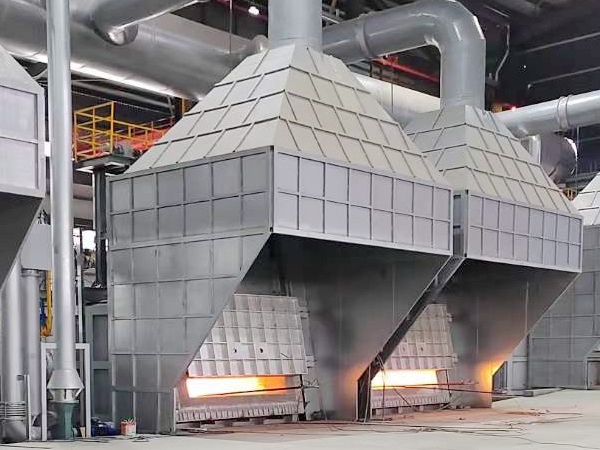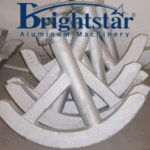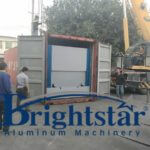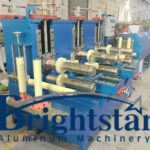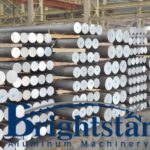9 benefits of Application of electromagnetic stirring technology in aluminum scrap recycling
9 benefits of Application of electromagnetic stirring technology in aluminum scrap recycling
Electromagnetic stirring technology
Electromagnetic stirring technology has been widely used in the production of primary aluminum.
The implementation of electromagnetic stirring technology can not only make the alloy composition of the melt uniform,
Moreover, it can reduce burning loss, increase melting speed, reduce energy consumption, and has high comprehensive benefits. These have become everyone’s consensus.
Implementing electromagnetic stirring technology in scrap aluminum recycling can also produce considerable economic and social benefits.
An electromagnetic stirrer (EMS) is a device that utilizes electromagnetic fields to generate a stirring motion in a conductive fluid, like molten metal.
The electromagnetic stirring device is mainly composed of a low-frequency power supply and an induction coil.
The induction coil, also called an inductor, is placed at the bottom or side of the furnace, usually at the bottom of the furnace.
The working principle of the electromagnetic stirring device is similar to that of a linear motor.
The inductor is equivalent to the stator of the motor, and the aluminum melt is equivalent to the rotor of the motor.
Therefore, it is equivalent to a linear asynchronous motor with a large air gap.
A low-speed alternating traveling wave magnetic field will be formed when a low-frequency current is passed through the inductor winding.
The molten liquid will generate induced electric potential and current under the action of the magnetic field.
This induced current interacts with the magnetic field to produce electromagnetic force, which makes the aluminum melt flows to achieve the purpose of stirring.
By changing the direction and intensity of the traveling wave magnetic field, the stirring direction and intensity of the melt can be effectively adjusted.
Function:
Creates a uniform flow within the liquid metal, ensuring proper mixing of components. This mixing is crucial for ensuring a homogenous final product.
Reduces dross formation by preventing stagnant zones. Dross is the layer of oxides that forms on the surface of the molten metal. By constantly moving the liquid metal, EMS prevents these oxides from accumulating and reduces the amount of waste generated.
Accelerates the melting process by promoting even heat distribution. EMS creates a circulatory motion within the molten metal, bringing cooler areas into contact with the heat source and accelerating the melting process.
Benefits of electromagnetic stirrer(EMS)
1. Increase the efficiency and reduce energy consumption
Can significantly shorten the melting time and reduce energy consumption
During the process of melting scrap aluminum into the furnace, the melt under the liquid surface is in a solid-liquid mixed state, and the convective heat transfer effect is reduced.
Suppose there is no effective method to achieve this. In that case, the rapid exchange of stirring between the upper and lower layers of liquid metal slows down the melting process, reduces the heat utilization rate, and consumes more heat.
Implementing electromagnetic stirring during this process can accelerate the flow of the solution, greatly improve the heat conduction efficiency, significantly shorten the melting time of solid aluminum, and save energy consumption.
In general, electromagnetic stirring can shorten the melting time by about 20% and reduce fuel consumption by about 15%.
2. Reduce burning loss and minimize dross formation
It can reduce the temperature difference between the upper and lower parts of the melt and reduce burning loss.
Aluminum dross is an inevitable product during the aluminum smelting process, and its formation is related to many factors.
Among many factors, the time that the aluminum liquid is exposed to the air and the surface temperature of the melt are two key factors that affect the formation of the slag.
When the temperature of the melt reaches above 750°C, the slag will increase sharply.
The application of electromagnetic stirring can accelerate the flow of the melt, speed up the melting process of aluminum, reduce the temperature difference between the upper and lower parts of the melt, and lower the surface temperature of the melt.
Thereby achieving reducing burning loss by 0. 3%-0. 5%, which allows users to recover their equipment investment within one year.
3. Improve the quality and make the alloy composition uniform
Can make the alloy composition uniform
In the process of preparing the alloy, electromagnetic stirring is sufficient, convenient and fast.
It can make the alloy composition uniform throughout the furnace in 10-30 minutes (depending on the size of the furnace and the alloy composition), especially for those with a high content of heavy metals.
The alloy can significantly reduce the component segregation of the entire melt, thus greatly improving the quality of the alloy and ensuring reliable product quality.
4. Extend the service life of the furnace
Easy for dross skimming, can reduce the frequency of furnace cleaning and extend the service life of the furnace
The application of electromagnetic stirring technology can reduce the generation of slag, and can also make the slag flow directionally to facilitate dross skimming.
At the same time, due to the continuous flow and erosion of molten aluminum, the phenomenon of slag adhering to the furnace wall is reduced, and the number of furnace cleaning times is reduced, thus extending the extends the service life of the furnace.
5. Increase efficiency and save labor cost
It can reduce the labor intensity of workers, improve working conditions, and reduce the number of people in each shift.
Since electromagnetic stirring technology greatly reduces workers’ labor intensity and improves workers’ working conditions, it can appropriately reduce the number of workers per shift and improve labor efficiency.
6. Refined Grain Structure
The controlled movement of the molten metal can influence the formation of a finer grain structure.
This potentially enhances the mechanical properties of the final product, making it stronger and more durable.
7. Reduced Defects
By preventing stagnant zones, EMS minimizes the formation of defects like oxides and voids within the metal.
This translates to a cleaner and more reliable end product.
8. Enhanced Mixing
EMS creates a uniform flow within the molten metal, ensuring thorough mixing of alloying elements and even distribution of components.
This homogeneity leads to a higher-quality final product with consistent properties.
9. Automate aluminum melting workshop
Creates conditions for the automation of the aluminum melting and casting process
As an intelligent terminal, the electromagnetic stirrer can be connected to the enterprise’s local area network and realize remote computer monitoring and operation, thereby creating conditions for the automation of the melting and casting process.
Installation of electromagnetic stirrer(EMS)
The main purpose of using electromagnetic stirring technology in the production process of primary aluminum is to make the alloy composition of the aluminum melt uniform, while in the recycling process of scrap aluminum.
The main purpose of using electromagnetic stirring technology is to melt scrap aluminum as quickly as possible, reduce burning loss, and increase the actual yield.
Of course, since the composition of scrap aluminum is inherently complex, long-term stirring is particularly important to adjust the composition and improve the uniformity of the composition.
We should reasonably set the installation position of the sensor of the electromagnetic stirring device according to different purposes of use.
Whether it is a square furnace, a round furnace, a single chamber or a double chamber furnace, the installation of the sensor can be roughly divided into two ways: bottom installation and side installation.
The bottom installation form is mainly used in new furnaces or furnaces where the depth of the molten pool changes greatly during the production process.
This form is not affected by changes in the depth of the melt and can achieve better-stirring effects.
In a scrap aluminum recycling furnace, the installation position should be offset from the center of the furnace, which can form a large circulation throughout the furnace and help melt scrap aluminum quickly.
The side-mounted sensor method is mainly used when old furnaces are renovated and the depth of the molten pool changes less than 200mm during the production process.
Installation method of electromagnetic stirring for single chamber furnace
In scrap aluminum recycling, the single-chamber furnace model has become a widely used model due to its advantages of low construction cost, high production efficiency, and the ability to recycle any form of scrap aluminum materials;
But its shortcomings are also obvious, such as: it is difficult to improve product quality and the burning loss is large, especially when recycling aluminum scraps, aluminum chips, aluminum foil and other scrap aluminum materials with large surface areas, which also brings disadvantages such as high energy consumption and heavy environmental pollution.
Therefore, single-chamber furnaces are currently mostly used for recycling large aluminum blocks and aluminum briquettes.
Bottom mounted installation
The sensor can be installed in the center of the furnace bottom of the single-chamber furnace, or it can be installed off-center.
Since most of the charging parts of the single-chamber furnace are in the center of the furnace, the eccentric installation of the sensor is conducive to the overall circulation of high-temperature melt, speeding up the melting speed and improving productivity.
The central installation of the inductor is beneficial to the formation of three-dimensional stirring of the furnace, which is beneficial to the uniformity of alloy composition and temperature.
It is generally used in static and holding furnaces.
When recycling scrap aluminum, different installation methods can be selected according to different situations.
Side mounted installation
The side-mounted installation of the sensor is conducive to the formation of a large circulation of the melt, but the circulation of the fluid is affected by factors such as the liquid depth, the aspect ratio of the furnace cavity, and the shape of the furnace.
Therefore, this installation method is mostly used in the renovation of old furnaces and in continuous production where the depth of the molten pool in the furnace is basically unchanged.
Installation method of electromagnetic stirring for double chamber furnace
Since single-chamber furnaces have relatively large burning losses when recycling aluminum scraps with relatively large surface areas, many users have adopted double-chamber or even multi-chamber furnaces in recent years to recycle this type of scrap aluminum.
The melt is heated, and scrap aluminum is added to the cold chamber.
There is a partition wall between the cold chamber and the hot chamber.
The hot and cold chambers are connected at the bottom of the melt.
In this way, the heat in the hot chamber will not be lost from the feeding port, which improves the thermal efficiency.
The electromagnetic stirrer is used to fully exchange the molten metal in the hot and cold chambers, so that the high-temperature aluminum liquid in the hot chamber enters the cold chamber to indirectly melt the scrap aluminum, thereby greatly increasing the actual metal yield and effectively improving the melting efficiency.
However, for scrap aluminum materials with larger surface areas such as aluminum chips and aluminum foil, the double-chamber furnace is also unable to do its job, because the double-chamber furnace cannot quickly and effectively vortex these scrap aluminum materials into the bottom of the melt, so the burning loss is large.
The melting efficiency is low; therefore, other recycling modes for aluminum chips and aluminum foil should be used.
Bottom mounted installation
Due to the special structure of the double-chamber furnace, the bottom installation of the inductor is eccentric and most of the inductors are on the side of the hot chamber.
This can reduce the resistance of the partition wall and affect the overall circulation, which is conducive to the exchange of hot and cold chambers.
Rounding or beveling the four inner corners of the furnace body is more beneficial to the overall circulation of the melt.
Side mounted installation
The side-mounted double-chamber furnace has high resistance to melt movement and is affected by the depth of the molten pool.
Therefore, the power of the sensor in this installation method is relatively large.
In order to reduce the power, the furnace wall can be modified to reduce the air gap.
The inductor installation is biased towards the hot chamber and is generally only used for old furnace modifications or special purposes.
Recycling of aluminum chips and aluminum foil and UBC
Application of bottom-mounted electromagnetic stirrer method
The electromagnetic stirrer is installed on one side of the bottom of the furnace.
Through electromagnetic thrust, the melt in the furnace forms a large circulation flow.
A small amount of scrap aluminum materials such as aluminum chips and aluminum foil and UBC are continuously added to the furnace through the upper feeding port.
This method is also effective for recycling other aluminum scraps.
The recycling efficiency of aluminum chips and aluminum foil is lower than that of aluminum scraps because it cannot effectively roll them into the bottom of the furnace quickly, but takes them away by the flow of the melt.
But the performance will be better than the ordinary double chamber furnace.
Aluminum chip recycling method using electromagnetic pump and side well technology
Aluminum chips double chamber melting furnace with side well vortex stirring
The electromagnetic pump and feeding well (side well) are placed on one side of the furnace and are connected to the furnace through the aluminum melt path.
The aluminum melt path should be opened at the bottom of the melt.
In the working, the electromagnetic pump is energized, and the aluminum melt is driven by the electromagnetic pump, flows through the feeding well and the aluminum path and re-enters the aluminum melting chamber.
Adjusting the electromagnetic thrust of the electromagnetic pump can make the aluminum melt in the feeding well form a strong vortex.
When scrap aluminum chips or UBC are added from the feeding well, they will be drawn into the bottom of the feeding well and sent into the melt.
The bottom of the furnace melts rapidly.
Since the scrap aluminum chips are not exposed to air during the melting process, burning loss can be greatly reduced and the recovery rate can be increased.
Another use of the feeding well is that other alloy components can be added directly to the feeding well, and the powerful vortex of the molten metal will quickly send it into the molten pool.
This method can greatly shorten the alloy addition time and dissolution time, improve the uniformity of alloy components, and improve the consistency of melt temperature.

